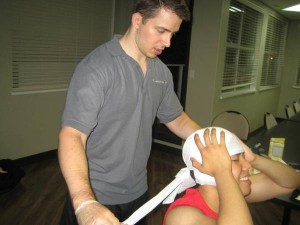Statistics back the importance of helmets in minimizing the number of head injuries. According to the Bicycle Helmet Safety Institute, around 540,000 bicycle riders in the United States receive emergency care in hospitals every year, around 67,000 sustain head injuries. Approximately 70 percent of the 800 cycling-related deaths recorded each year result from traumatic brain injury. The sad part is that almost half of those deaths involve children under 15. Helmets could cut serious brain injuries by up to 88 percent, but unfortunately only 25 percent of the 85 million bicycle riders in the US wear them. Emergency first aid is very useful during this kind of incidents.
Wearing helmets is not just for bicycle riders. Climbers and outdoor enthusiasts are also at risk for head injuries. In fact, head injury is considered the third leading cause of death for climbers. Rocks, debris, ice, and many other falling objects pose great risks, though are not limited to these. Falls from great heights and bumping the head can instantly cause traumatic brain injuries.
The use of helmets is also highly recommended for people who are into skiing and snowboarding. According to the U.S. Consumer Products Safety Commission, around 7,700 head injuries and 11 deaths could have been prevented by just wearing an appropriate helmet. Helmet use could prevent or minimize skiing- or snowboard-related head injuries by up to 44 percent, and approximately 53 percent of head injuries sustained by children under 15.
Considering the great benefit of having proper head protection, it is recommended that all outdoor activities or sports that involve agility and speed should ensure some form of head protection. Individuals who participate in high risk activities such as skateboarding, riding a scooter, kayaking, surf boating, or inline skating should wear helmets at all times. Get enrolled on a standard first aid training course to learn more about safety procedures and precautions.
However, the use of helmet should not just be for display or compliance. The helmet should be appropriate for the activity or outdoor sport so that it can properly protect the wearer’s head. Each helmet is designed for specific activity. They undergo series of tests and evaluations that cover everything from its strength and retention under different environmental condition to the effects of velocity forces and multiple impacts in specific points of the helmet. Although all helmets sold in the U.S. are expected to pass these performance standards, you should be wary of helmets that may have been manufactured from other parts of the world and fall below the standards.
It is critical that you choose a helmet that is not only designed for the activity but also fits your head exactly. Before you buy one, make sure to try out different models. The helmet should comfortably fit in your head without any gaps on the back or sides. The front brim must go straight across the forehead but not cover your eyesight. It should not move front to back or side to side, even when the strap is not yet buckled. Take note that most helmets come in multiple sizes, so choose the one that best protects your head.
Wearing a helmet is one crucial step in preventing serious, debilitating head injuries. Don’t forget: staying safe is more fun!

